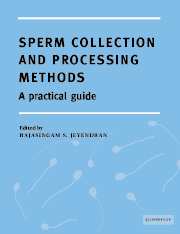Part 2 - Sperm processing methods
Published online by Cambridge University Press: 11 March 2010
Summary
Natural fertilization
Immediately following ejaculation, semen forms into a coagulum which effectively traps all sperm within a viscous medium. During coitus, the ejaculated coagulum becomes deposited around the external orifice of the cervix and the posterior fornix of the vagina. Freshly ejaculated, this coagulated semen protects sperm from the otherwise harsh vaginal environment, and facilitates sperm transport through the cervix and into the fallopian tubes.
As the coagulum begins to liquefy, otherwise trapped sperm are released into the surrounding environment. A majority of motile sperm with normal forms will then rapidly penetrate and migrate into the cervical mucus. A tiny fraction of these sperm might eventually reach the oocyte within the fertilization area. Those sperm remaining behind within the vagina are inactivated and summarily destroyed, likely due to the relatively high acidity of the vaginal confines.
The capacitation reaction
Interestingly enough, healthy sperm, although fully formed at the moment of ejaculation, are not yet able, in and of themselves, to fertilize an egg. Prior to making contact with the oocyte, sperm must undergo further physiological maturation possible only within the female reproductive tract, a process called “capacitation.” (Artificial capacitation, performed in vitro, is commonly utilized in the laboratory.)
Such capacitation is inhibited outside the female in order to conserve sperm fertilization capacity. Specifically, decapacitating factor(s) present within the seminal plasma itself prevent sperm from undergoing spontaneous and independent capacitation reactions. Once semen has been ejaculated into the vagina, however, the cervical mucus also prevents these decapacitating factor(s) from ever entering the inner female reproductive tract, facilitating the capacitation processes going on within.
- Type
- Chapter
- Information
- Sperm Collection and Processing MethodsA Practical Guide, pp. 105 - 110Publisher: Cambridge University PressPrint publication year: 2003



